-
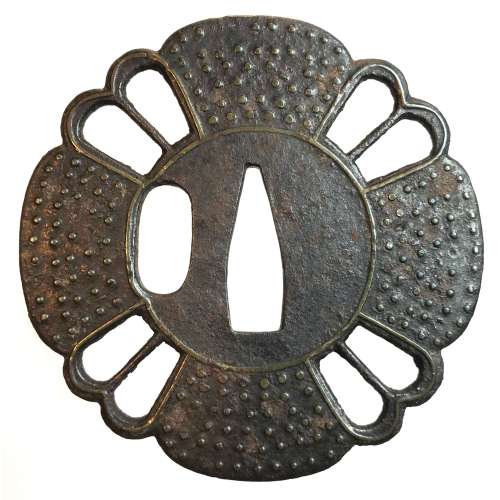 An iron tsuba of 12-lobed form with alternating four solid and four openwork areas, each with a central bar. Symbolism remains unclear, possibly - a gunbai, i.e. military leader's fan. The solid parts decorated with 5 to 6 rows of brass dots of nail heads inlaid in ten-zōgan. The center of the plate as well as the sukashi elements are outlined with brass wire. The kozuka-hitsu-ana seems original. Muromachi period. Dimensions: 77.9 x 77.5 x 3.2 mm.
An iron tsuba of 12-lobed form with alternating four solid and four openwork areas, each with a central bar. Symbolism remains unclear, possibly - a gunbai, i.e. military leader's fan. The solid parts decorated with 5 to 6 rows of brass dots of nail heads inlaid in ten-zōgan. The center of the plate as well as the sukashi elements are outlined with brass wire. The kozuka-hitsu-ana seems original. Muromachi period. Dimensions: 77.9 x 77.5 x 3.2 mm. -
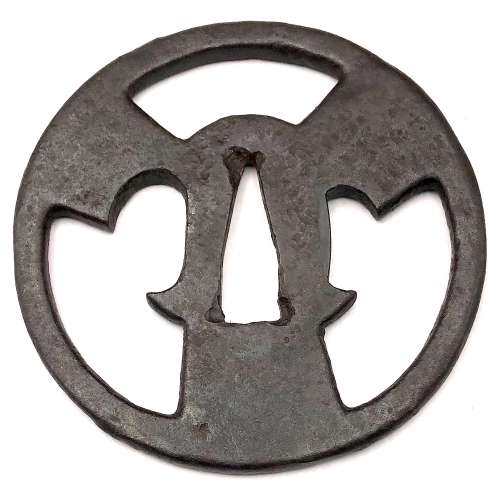 Iron tsuba of round form with three stylized folding fans motif in openwork (sukashi). Kogai-hitsu-ana with shakudō sekigane. Iron bones (tekkotsu) on the rim. Momoyama period or earlier. Possibly, Ko-Shōami school.
Iron tsuba of round form with three stylized folding fans motif in openwork (sukashi). Kogai-hitsu-ana with shakudō sekigane. Iron bones (tekkotsu) on the rim. Momoyama period or earlier. Possibly, Ko-Shōami school.Size: 76.8 x 75.7 x 4.0 mm.
[Seller alleged that the motif is "Buddhist wheel", which seems unlikely. -
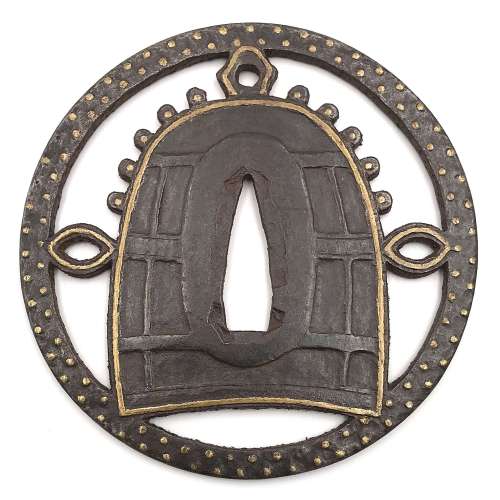
Iron tsuba of round form with brown patina decorated with the design of a Buddhist temple bell (tsurigane) in openwork (sukashi), with details outlined in brass wire (sen-zōgan), the outer ring decorated with two rows of brass dots (ten-zōgan), and the bell details carved in sukidashi-bori as on kamakura-bori pieces.
Ōnin school. Unsigned. Late Muromachi period, 16th century. Dimensions: 88.8 x 88.3 x 3.0 mm. As per Merrily Baird, two legends are usually associated with the image of tsurigane, a large, suspended Buddhist bell: one is that of Dojo Temple (Dojo-ji), and the other is of Benkei stealing the tsurigane of Miidera Temple. Interestingly, this type of bell (tsurigane) is not described as a family crest (mon), while suzu and hansho bells are. -
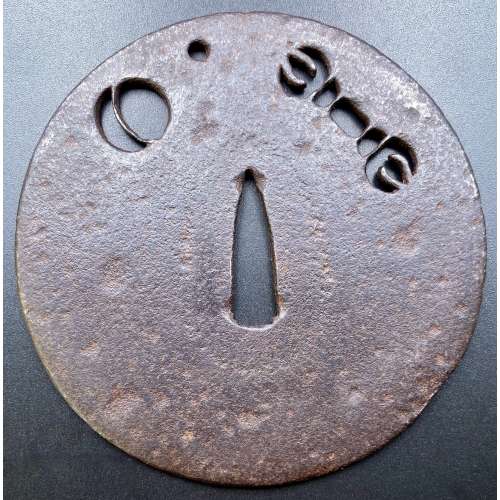 A ko-tosho tsuba made of iron, of the round form (丸型, maru-gata), pierced in negative silhouette (文透, mon-sukashi) with the design of Shingon Buddhism symbols of vajra [金剛杵] (kongosho), Sun, Moon and Star [月日星] (tsuki-hi-hoshi) – three sources of light [三光] (sankō). Round rim. No hitsu-ana; the shape of nakago-ana may suggest use on naginata [薙刀. Muromachi period (1393 – 1573). Height: 94.4 mm, Width: 93.4 mm, Centre thickness: 3.1 mm. Another possible explanation for "The element at the 11-o’clock position is in my opinion a kemari ball for the courtly game of the same name (picture attached)" [Markus Sesko].
A ko-tosho tsuba made of iron, of the round form (丸型, maru-gata), pierced in negative silhouette (文透, mon-sukashi) with the design of Shingon Buddhism symbols of vajra [金剛杵] (kongosho), Sun, Moon and Star [月日星] (tsuki-hi-hoshi) – three sources of light [三光] (sankō). Round rim. No hitsu-ana; the shape of nakago-ana may suggest use on naginata [薙刀. Muromachi period (1393 – 1573). Height: 94.4 mm, Width: 93.4 mm, Centre thickness: 3.1 mm. Another possible explanation for "The element at the 11-o’clock position is in my opinion a kemari ball for the courtly game of the same name (picture attached)" [Markus Sesko].
Tsukioka Yoshitoshi [月岡 芳年] (Japan, 1839 – 1892): Tokugawa Yoshimune [徳川 吉宗] (1684 – 1751) playing kemari [蹴鞠]
-
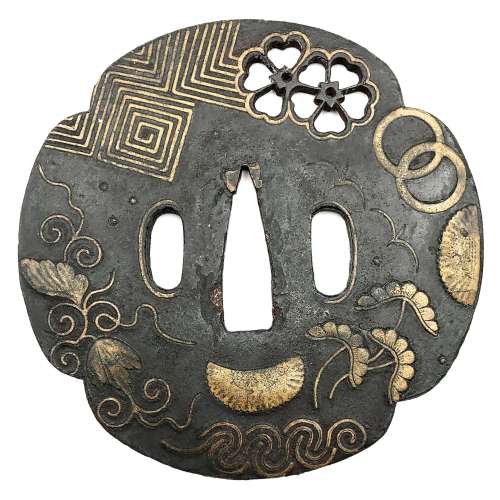 Iron tsuba of mokko form (quatrefoil) decorated with a pair of cherry blossoms (sakura) in small openwork (ko-sukashi) and inlaid in brass (suemon-zōgan) with designs of waves, distant pines, chrysanthemum flowers in halves, tendrils and leaves, lightning or thunder symbol (inazuma), flying geese and family chrests (mon): two interlocked rings (wachigai) on the face, and three encircled stripes (maru-no-uchi-ni-mitsuhikiryo) - kamon of the Kikkawa clan - on the reverse. Hitsu-ana outlined with inlay of brass wire. Surface treated with lacquer. Copper sekigane. Though some consider this type of tsuba to resemble Heianjo school, “...the brass trim around the hitsu-ana is a characteristics of Ōnin work” [Japanese sword guards. Onin – Heianjo – Yoshiro. Gary D. Murtha. GDM Publications, 2016; p. 27.]. The Ōnin origin is reinforced by scattered ten-zōgan elements here and there through the plate. It is possible that the tsuba was initially of round form and later trimmed to mokko shape. Mid Muromachi period; 15th century. Dimensions: Height: 87.2 mm; Width: 87.9 mm; Thickness at seppa-dai: 3.6 mm.
Iron tsuba of mokko form (quatrefoil) decorated with a pair of cherry blossoms (sakura) in small openwork (ko-sukashi) and inlaid in brass (suemon-zōgan) with designs of waves, distant pines, chrysanthemum flowers in halves, tendrils and leaves, lightning or thunder symbol (inazuma), flying geese and family chrests (mon): two interlocked rings (wachigai) on the face, and three encircled stripes (maru-no-uchi-ni-mitsuhikiryo) - kamon of the Kikkawa clan - on the reverse. Hitsu-ana outlined with inlay of brass wire. Surface treated with lacquer. Copper sekigane. Though some consider this type of tsuba to resemble Heianjo school, “...the brass trim around the hitsu-ana is a characteristics of Ōnin work” [Japanese sword guards. Onin – Heianjo – Yoshiro. Gary D. Murtha. GDM Publications, 2016; p. 27.]. The Ōnin origin is reinforced by scattered ten-zōgan elements here and there through the plate. It is possible that the tsuba was initially of round form and later trimmed to mokko shape. Mid Muromachi period; 15th century. Dimensions: Height: 87.2 mm; Width: 87.9 mm; Thickness at seppa-dai: 3.6 mm. -
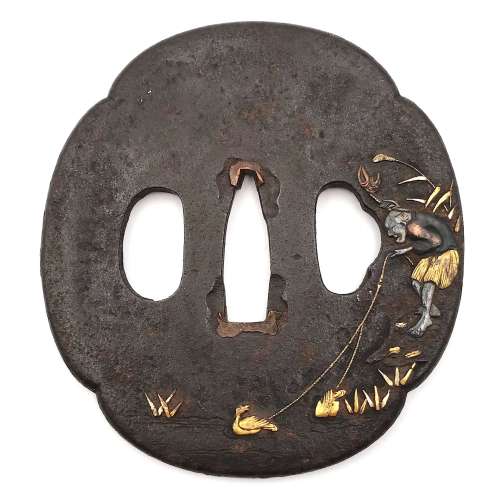 Mokkō form iron tsuba carved in relief and inlaid with soft metals (copper, gold, silver) with the design of a cormorant fisherman on the face and a boat on the reverse. Unsigned. Dimensions: 77 mm x 69 mm x 3.0 mm (at seppa-dai) Edo period: 18th or 19th century. "Since Nara period, Japanese fishermen in small boats have used cormorants (u) to catch river fish at night, binding the necks of the birds so that the fish are not swallowed. [...] The bird and the work it performs are symbols of selfless devotion to one's master and keen eyesight." - from Merrily Baird. Symbols of Japan. Thematic motifs in art and design. Rizzoli international publications, Inc., 2001; p. 104. See also in this collection TSU-0212 and TSU-0241.
Mokkō form iron tsuba carved in relief and inlaid with soft metals (copper, gold, silver) with the design of a cormorant fisherman on the face and a boat on the reverse. Unsigned. Dimensions: 77 mm x 69 mm x 3.0 mm (at seppa-dai) Edo period: 18th or 19th century. "Since Nara period, Japanese fishermen in small boats have used cormorants (u) to catch river fish at night, binding the necks of the birds so that the fish are not swallowed. [...] The bird and the work it performs are symbols of selfless devotion to one's master and keen eyesight." - from Merrily Baird. Symbols of Japan. Thematic motifs in art and design. Rizzoli international publications, Inc., 2001; p. 104. See also in this collection TSU-0212 and TSU-0241. -
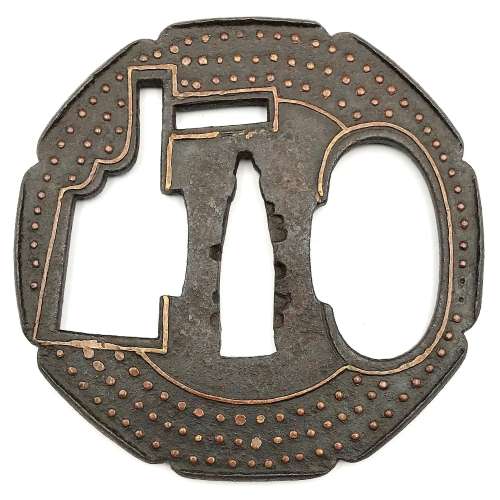 Iron tsuba of octafoil form with design of rudder (kaji) and lake in openwork (sukashi) outlined with brass wire. Thin plate also decorated with three concentric circular rows of brass dots (nail heads) in ten-zōgan. Center of the plate outlined with the inlaid circular brass wire. Cut-outs for kozuka and kogai probably added later. Slightly raised rim between the indentations (suki-nokoshi-mimi). The inlaid metal of red-ish hue, so it may be copper, not brass. Sekigane, visible on the NBTHK paper photo, are missing, possibly removed by a previous owner. Muromachi period. Ōnin school. Unsigned. Dimensions: 81.2 mm x 81.8 mm x 2.7 mm. Weight: 79.0 g. Large nakago-ana: 34 mm high and 10 mm wide. NBTHK certificate №455786: Hozon. Note regarding design: it was quite hard to interpret the big oval opening. The first suggestion was 'sea cucubmer', and it was based on a design published by Kazutaro Torigoye [Kodogu and tsuba. International collections not published in my books (Toso Soran), 1978] on page 202: Katchūshi tsuba: Sea cucumber and butterfly. Look and judge yourself:The second suggestion - 'lake' - came from [Iron tsuba. The works of the exhibition "Kurogane no hana", The Japanese Sword Museum, 2014], page 14 №5:
Iron tsuba of octafoil form with design of rudder (kaji) and lake in openwork (sukashi) outlined with brass wire. Thin plate also decorated with three concentric circular rows of brass dots (nail heads) in ten-zōgan. Center of the plate outlined with the inlaid circular brass wire. Cut-outs for kozuka and kogai probably added later. Slightly raised rim between the indentations (suki-nokoshi-mimi). The inlaid metal of red-ish hue, so it may be copper, not brass. Sekigane, visible on the NBTHK paper photo, are missing, possibly removed by a previous owner. Muromachi period. Ōnin school. Unsigned. Dimensions: 81.2 mm x 81.8 mm x 2.7 mm. Weight: 79.0 g. Large nakago-ana: 34 mm high and 10 mm wide. NBTHK certificate №455786: Hozon. Note regarding design: it was quite hard to interpret the big oval opening. The first suggestion was 'sea cucubmer', and it was based on a design published by Kazutaro Torigoye [Kodogu and tsuba. International collections not published in my books (Toso Soran), 1978] on page 202: Katchūshi tsuba: Sea cucumber and butterfly. Look and judge yourself:The second suggestion - 'lake' - came from [Iron tsuba. The works of the exhibition "Kurogane no hana", The Japanese Sword Museum, 2014], page 14 №5:
Torigoye: sea cucumber and butterfly.
Opening on my tsuba looks more like the 'lake'. Also, rudder and lake make more sense than rudder and sea cucumber. At least to me...
Ko-Katchūshi tsuba: Lake and pine.
-
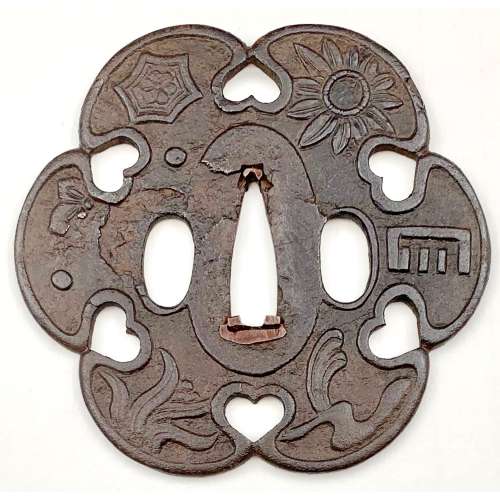 Iron tsuba of six-lobed (mutsu-mokkō-gata) form, with six wild boar's eye shape (inome) openings (sukashi). Ryo-Hitsu and the entire perimeter of tsuba have typical for this school raised rim; raised seppa dai. Lobes are decorated in low relief carving (sukidashi-bori). On the obverse: chrysanthemum, Genji mon, waves and rocks, grasses and star, bellflower, star and flower in tortoiseshell (kikko). On the reverse: Stars and different flowers, and flying geese. The plate is damaged to the left of nakago-ana and around the left hitsu-ana. Kamakura-bori school. Late Muromachi period (1514-1573). Diameter: 89 mm; Thickness at seppa-dai: 4.0 mm; Weight: 108.8 g [large]. There is a similar tsuba in this collection, TSU-0345.2018, but with a different motif and much smaller: diameter 74.3 mm, thickness at seppa-dai: 3.2 mm, weight: 62.8 g.Another look-a-like tsuba can be found at the Compton Collection, part II, pp. 14-15, №17, though his tsuba is more massive (80 x 84 x 4 mm).
Iron tsuba of six-lobed (mutsu-mokkō-gata) form, with six wild boar's eye shape (inome) openings (sukashi). Ryo-Hitsu and the entire perimeter of tsuba have typical for this school raised rim; raised seppa dai. Lobes are decorated in low relief carving (sukidashi-bori). On the obverse: chrysanthemum, Genji mon, waves and rocks, grasses and star, bellflower, star and flower in tortoiseshell (kikko). On the reverse: Stars and different flowers, and flying geese. The plate is damaged to the left of nakago-ana and around the left hitsu-ana. Kamakura-bori school. Late Muromachi period (1514-1573). Diameter: 89 mm; Thickness at seppa-dai: 4.0 mm; Weight: 108.8 g [large]. There is a similar tsuba in this collection, TSU-0345.2018, but with a different motif and much smaller: diameter 74.3 mm, thickness at seppa-dai: 3.2 mm, weight: 62.8 g.Another look-a-like tsuba can be found at the Compton Collection, part II, pp. 14-15, №17, though his tsuba is more massive (80 x 84 x 4 mm).
Varshavsky Collection: TSU-0345.2018
This tsuba, TSU-0401.2019, is the biggest of all three (another mine and the one from Campton Collection). The presence of a flower in a tortoiseshell symbol (crest or mon) on this tsuba alludes to Izumo Shrine. The overall piece, with symbols of grasses, waves, flowers, incense, stars, and flying geese, is full of autumnal connotations.
Compton Collection, part II, pp. 14-15, №17: Kamakura-bori tsuba, ca. 1450.
-
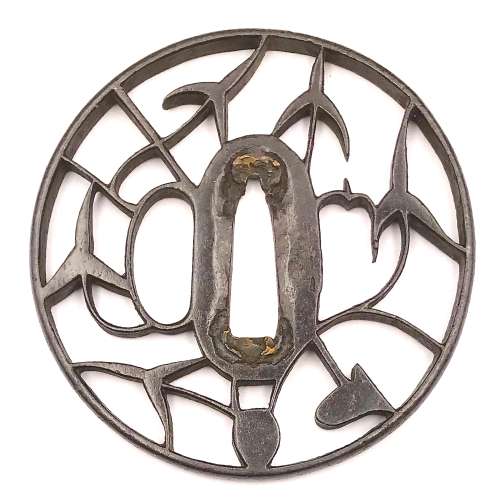 Iron tsuba of round form with design of water plantain (omodaka) and wild goose in openwork (sukashi). Slightly rounded, square rim. Copper sekigane. Kyo school. Late Muromachi period: Early 16th century (Tenbun era) [Sasano's attribution]. Height: 76.2 mm. Width: 75.8 mm. Rim thickness: 5.3 mm. Center thickness: 4.5 mm. Provenance: Sasano Masayuki Collection, № 68: "The water plantain (omodaka) first appeared as a design for sword fittings in the Heian period. From such early beginnings, this decorative plant has shared a long history with the samurai. Also known as shogun's grass (shogununso), it was held in high esteem as a symbol of victory". The same tsuba was found at Japanese Swords and Tsuba from the Professor A. Z. Freeman and the Phyllis Sharpe Memorial collections. Sotheby's, London, Thursday 10 April 1997, page 22, item 60, saying that this is a "Kyo-sukashi tsuba, early to middle Edo period (late 17th/18th century) [Sotheby's attribution], and that it represents "a small bird among omodaka and aoi plants".
Iron tsuba of round form with design of water plantain (omodaka) and wild goose in openwork (sukashi). Slightly rounded, square rim. Copper sekigane. Kyo school. Late Muromachi period: Early 16th century (Tenbun era) [Sasano's attribution]. Height: 76.2 mm. Width: 75.8 mm. Rim thickness: 5.3 mm. Center thickness: 4.5 mm. Provenance: Sasano Masayuki Collection, № 68: "The water plantain (omodaka) first appeared as a design for sword fittings in the Heian period. From such early beginnings, this decorative plant has shared a long history with the samurai. Also known as shogun's grass (shogununso), it was held in high esteem as a symbol of victory". The same tsuba was found at Japanese Swords and Tsuba from the Professor A. Z. Freeman and the Phyllis Sharpe Memorial collections. Sotheby's, London, Thursday 10 April 1997, page 22, item 60, saying that this is a "Kyo-sukashi tsuba, early to middle Edo period (late 17th/18th century) [Sotheby's attribution], and that it represents "a small bird among omodaka and aoi plants". -
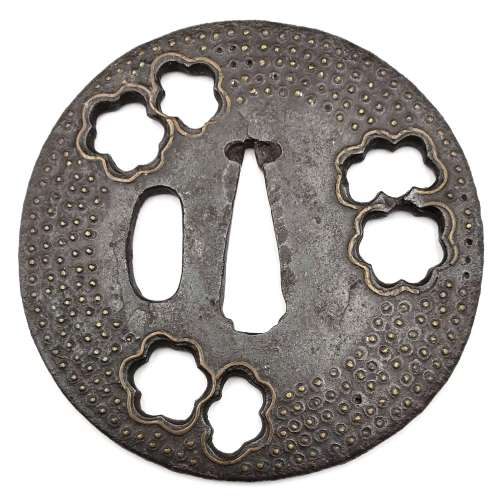 Iron tsuba of slightly elongated round form decorated with three pairs of snowflake-form small perforations (ko-sukashi), each outlined with brass wire; five concentric circular rows of dots inlaid in brass or copper ten-zōgan (some dots are missing). Hitsu-ana of oval form. Ōnin school. Unsigned. Late Muromachi period. Dimensions: 75.6 mm x74.6 mm x 3.0 mm. Weight: 78.0 g. Old NBTHK certificate (green paper): Tokubetsu Kicho - "Extraordinary Work". Unlike most Ōnin ten-zōgan tsuba this one does not have circular brass wire inlay inside the dots area; neither it has brass trim around seppa-dai or hitsu-ana.
Iron tsuba of slightly elongated round form decorated with three pairs of snowflake-form small perforations (ko-sukashi), each outlined with brass wire; five concentric circular rows of dots inlaid in brass or copper ten-zōgan (some dots are missing). Hitsu-ana of oval form. Ōnin school. Unsigned. Late Muromachi period. Dimensions: 75.6 mm x74.6 mm x 3.0 mm. Weight: 78.0 g. Old NBTHK certificate (green paper): Tokubetsu Kicho - "Extraordinary Work". Unlike most Ōnin ten-zōgan tsuba this one does not have circular brass wire inlay inside the dots area; neither it has brass trim around seppa-dai or hitsu-ana. -
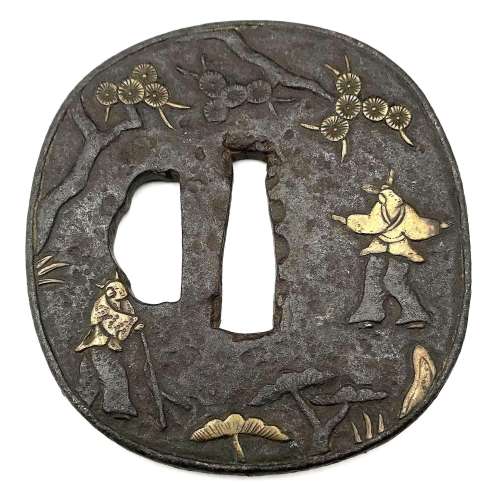 Relatively thick iron tsuba of rounded square form with slightly elevated rim decorated in carving (sukidashi-bori) and yellow brass (shinchū) inlay (suemon-zōgan) with legendary creatures (humans with cow heads) in a pine tree forrest on the face, and a horned man with a stick hunting a rabbit in the woods on the reverse. Large hitsu-ana possibly cut off later on. In the beginning of the 20th century such tsuba were usually attributed to Fushimi-Kaga school. This one may be attributed to either Ōnin or to Heianjō. The latter seems most plosible because of the thick web and dull patina. The technique may also be called "shinchū-zōgan". Momoyama or early Edo period. Unsigned. Dimensions: 72.3 x 68.4 x 4.1 mm
Relatively thick iron tsuba of rounded square form with slightly elevated rim decorated in carving (sukidashi-bori) and yellow brass (shinchū) inlay (suemon-zōgan) with legendary creatures (humans with cow heads) in a pine tree forrest on the face, and a horned man with a stick hunting a rabbit in the woods on the reverse. Large hitsu-ana possibly cut off later on. In the beginning of the 20th century such tsuba were usually attributed to Fushimi-Kaga school. This one may be attributed to either Ōnin or to Heianjō. The latter seems most plosible because of the thick web and dull patina. The technique may also be called "shinchū-zōgan". Momoyama or early Edo period. Unsigned. Dimensions: 72.3 x 68.4 x 4.1 mm -
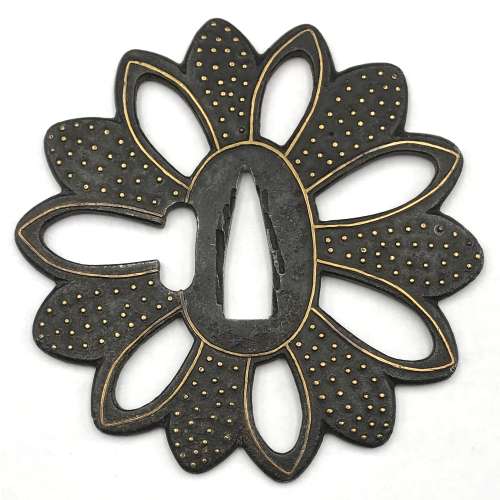 Iron tsuba of 14-petal chrysanthemoid form (kikka-gata) with alternating solid and openwork petals, the latter outlined with brass wire (sen-zōgan) and the former decorated with brass dots (ten-zōgan), on both sides. Seppa-dai is outlined with brass wire. Small hitsu-ana probably cut later. Late Muromachi period (Ca. 1514-1573). Ōnin school. Unsigned. Dimensions: 87.0 x 87.8 x 3.2 mm. Similar tsuba in this collection: TSU-0420.2022
Iron tsuba of 14-petal chrysanthemoid form (kikka-gata) with alternating solid and openwork petals, the latter outlined with brass wire (sen-zōgan) and the former decorated with brass dots (ten-zōgan), on both sides. Seppa-dai is outlined with brass wire. Small hitsu-ana probably cut later. Late Muromachi period (Ca. 1514-1573). Ōnin school. Unsigned. Dimensions: 87.0 x 87.8 x 3.2 mm. Similar tsuba in this collection: TSU-0420.2022 Other similar specimens can be found at:
Henri L. Joly and Kumasaku Tomita, Japanese art and handicraft, "Swords and sword fittings" section, sub-section “Inlays of Ōnin, Kyoto, Fushimi-Yoshiro, and Kaga Province”, Plate CX, #128: Iron, chrysanthemoid, thin guard with alternate petals covered with brass spots. Ōnin style. 16th century.
Compton Collection, Part I, #7: The iron plate is of flowerhead shape with each of the fourteen petals alternating between solid and openwork. The apertures are outlined in inlaid brass as is the seppa-dai and hitsu-ana. The remainder of the plate is similarly inlaid with plum flowers, birds, dots of dew, Genji mon and sambiki mon. 87 mm x 85 mm x 3.5 mm.
Other similar specimens can be found at:
Henri L. Joly and Kumasaku Tomita, Japanese art and handicraft, "Swords and sword fittings" section, sub-section “Inlays of Ōnin, Kyoto, Fushimi-Yoshiro, and Kaga Province”, Plate CX, #128: Iron, chrysanthemoid, thin guard with alternate petals covered with brass spots. Ōnin style. 16th century.
Compton Collection, Part I, #7: The iron plate is of flowerhead shape with each of the fourteen petals alternating between solid and openwork. The apertures are outlined in inlaid brass as is the seppa-dai and hitsu-ana. The remainder of the plate is similarly inlaid with plum flowers, birds, dots of dew, Genji mon and sambiki mon. 87 mm x 85 mm x 3.5 mm.
Japanese art and handicraft, Plate CX, #128.
And at Jim Gilbert website: Onin ten zogan tsuba, mid Muromachi. Size: 7.7 cm T x 7.6 cm W x 0.3 cm. Iron plate with brass inlay. Kiku gata. The Ōnin ten zogan style is characterized by the decoration of small brass “nail heads” and wires on a thin iron plate. The iron often has a soft, granular texture and seems to be prone to rust. Unfortunately, this rust will undermine the brass inlay and result in the loss of some of the inlay. This example is in reasonably good but far from perfect condition. As is often the case, the backside is better preserved, with the wire around the seppa-dai and kozuka-ana, and all petals still intact.
Compton Collection, Part I, #7.
-

The thin iron plate of round form and black colour carved in sukidashi-bori with the design of rocks, waves, bridge, mountain pavilion and 5-storey pagoda under the moon, on both sides, alluding to Todai-ji temple in Nara. Slightly rounded rectangular hitsu-ana probably pierced later. Very narrow raised rim as usual in katsushi tsuba. In a modern wooden box.
Late Muromachi period, 16th century. Dimensions: 81.1 x 79.5 x 3. mm (seppa-dai), 2.2 mm (base plate), 4.4. (rim).Reference: “Art of the Samurai” on page 232, №140: ”Kamakura tsuba with Sangatsu-do tower and bridge. Muromachi period, 16th century. 83 mm x 80 mm. Unsigned. Tokyo National Museum. The mountain pavilion and bridge carved in sunken relief on the iron tsuba – both part of Tōdai-ji, a temple in Nara – are detailed in fine kebori (line) engraving. As a result of the chiselling used to create the relief, the ground of the piece is relatively thin”. Also page 41 in Tsuba Kanshoki. Kazutaro Torogoye, 1975 [LIB-1480.2018].
This tsuba is very much similar to TSU-0384. -
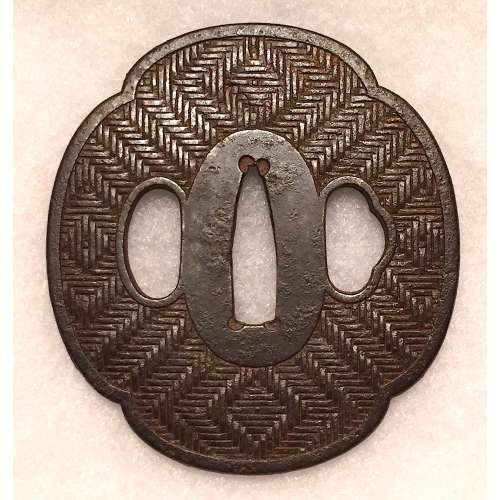 Iron tsuba with brown patina in mokkō-gata form with woven design. Size: 72 x 67 x 5 mm.
Iron tsuba with brown patina in mokkō-gata form with woven design. Size: 72 x 67 x 5 mm. -
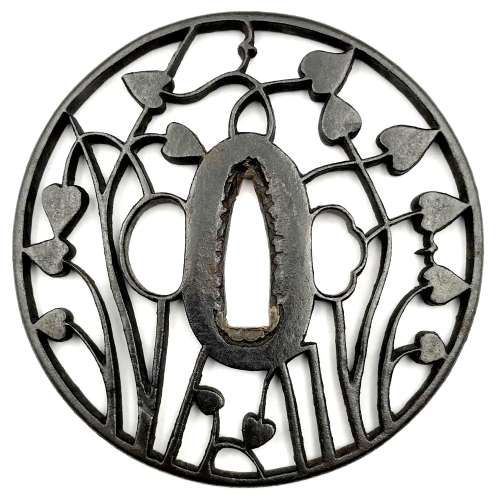 Kyo-sukashi iron tsuba of round form with design of hollyhock (aoi ) and wild geese. Slightly rounded rim. Copper sekigane. Momoyama period, late 16th - early 17th century. Height: 82.6 mm, Width: 82.1 mm, Thickness at seppa-dai: 4.5 mm. NTHK (Nihon Token Hozon Kai) certified.
Kyo-sukashi iron tsuba of round form with design of hollyhock (aoi ) and wild geese. Slightly rounded rim. Copper sekigane. Momoyama period, late 16th - early 17th century. Height: 82.6 mm, Width: 82.1 mm, Thickness at seppa-dai: 4.5 mm. NTHK (Nihon Token Hozon Kai) certified. -
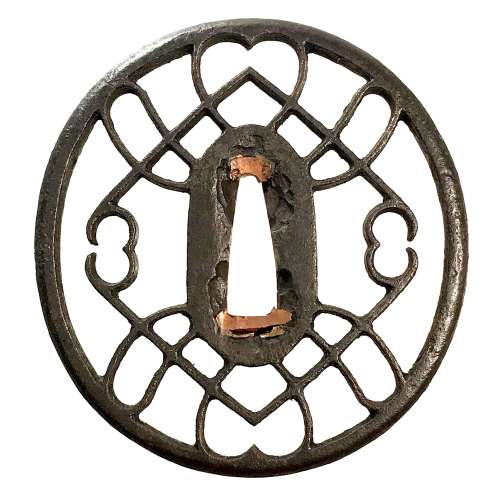 Iron tsuba of oval form with the motif of horse trappings in openwork (sukashi). Copper sekigane. Iron bones (tekkotsu) on the rim.
Iron tsuba of oval form with the motif of horse trappings in openwork (sukashi). Copper sekigane. Iron bones (tekkotsu) on the rim.Size: 80.4 x 75.8 x 5.2 mm
NBTHK Certificate №454567, allegedly saying that it is Akasaka School, Muromachi period. A look-a-like tsuba in Robert. E. Haynes Catalog #7, 1983 on page 57 under №48 is described as follows: "A masterpiece second period Owari sukashi tsuba. The plate is of beautiful color and quality almost like velvet. The design is very hard to discern, it might be the horse trappings, or even a moon. The style and type of Owari tsuba shows the great tradition of the Momoyama period and why it was the renaissance in time, as well as the arts produced, through the long history of all Japanese art. Ca. 1580. Ht. 7.7 cm, Th. (center) 5.5 mm, (edge) 5.25 to 5.75 mm."I believe we can safely attribute this tsuba to Owari School, c. 1580.
Robert. E. Haynes Catalog #7, 1983, p. 57, №48.
-
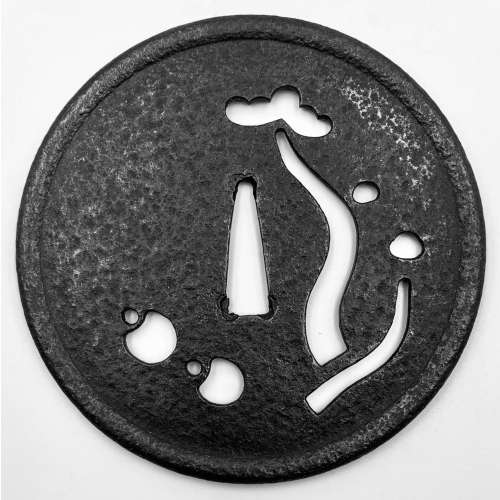
Iron tsuba of circular form with design of pine trees (matsu) and monkey toys (kukurizaru) in openwork (ko-sukashi). Ko-Katchushi school.
Raised rim (mimi) with iron bones (tekkotsu). Size: Diameter: 99.5 mm; Thickness: 2.1 mm at centre; 4.3 mm at the rim.Early Muromachi period: 15th century (Kakitsu - Bun'an era, 1441 - 1449).
-
 Iron tsuba of the round form (丸型, maru–gata), decorated with brass flat inlay (平象嵌, hira-zōgan) of bellflowers, leaves, and vines on both sides, inlaid brass is carved in low relief; wide rim (dote-mimi) also inlaid; the plate is pierced with hitsu-ana (probably original); nakago-ana plugged with copper sekigane. Dimensions: Height: 84.1 mm; Width: 82.0 mm; Thickness (centre): 2.8 mm; mimi is 11.8 mm wide and 4.7 mm thick. Produced at the end of the 16th century, in the Momoyama period (1674–1703).
Iron tsuba of the round form (丸型, maru–gata), decorated with brass flat inlay (平象嵌, hira-zōgan) of bellflowers, leaves, and vines on both sides, inlaid brass is carved in low relief; wide rim (dote-mimi) also inlaid; the plate is pierced with hitsu-ana (probably original); nakago-ana plugged with copper sekigane. Dimensions: Height: 84.1 mm; Width: 82.0 mm; Thickness (centre): 2.8 mm; mimi is 11.8 mm wide and 4.7 mm thick. Produced at the end of the 16th century, in the Momoyama period (1674–1703).


